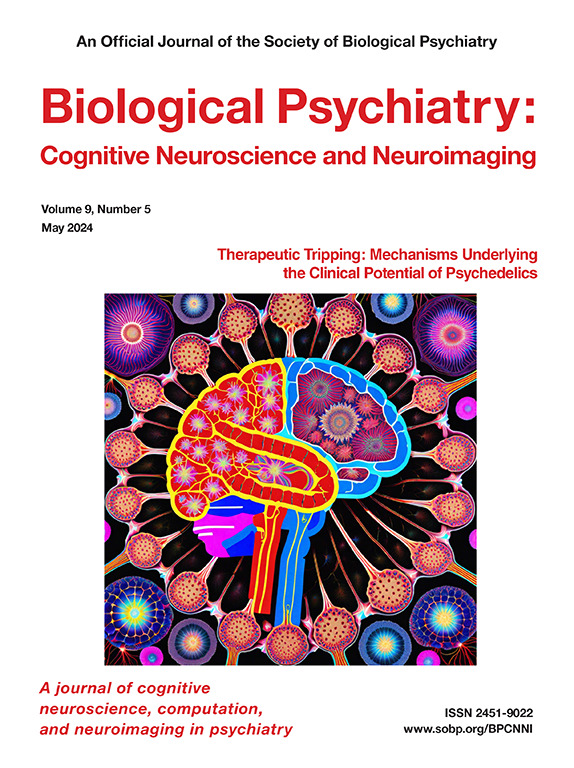重性抑郁症和边缘型人格障碍情绪加工的跨诊断和障碍特异性神经关联:基于坐标和基于图像的比较meta分析。
IF 4.8
2区 医学
Q1 NEUROSCIENCES
Biological Psychiatry-Cognitive Neuroscience and Neuroimaging
Pub Date : 2025-08-01
DOI:10.1016/j.bpsc.2025.03.009
引用次数: 0
摘要
背景:重度抑郁障碍(MDD)和边缘型人格障碍(BPD)涉及消极和积极情绪处理的实质性障碍。本荟萃分析旨在确定MDD和BPD在处理消极和积极刺激过程中的跨诊断和疾病特异性神经异常。方法:目前基于坐标和基于图像的荟萃分析包括42项涉及MDD的fMRI研究(42项阴性研究对22项阳性研究;1532名重度抑郁症患者对1481名健康对照)和25名BPD患者(23项阴性研究对7项阳性研究;522名BPD患者与519名健康对照)。结果:与健康对照相比,MDD患者在负性情绪加工过程中表现为左中央前回低反应性,在正性情绪加工过程中表现为左颞叶、脑岛和双侧前扣带皮层激活降低,而BPD患者在负性情绪加工过程中表现为左海马和杏仁核高反应性,右额下回低反应性。与BPD相比,MDD在消极情绪加工过程中双侧前扣带皮层和在积极情绪加工过程中左颞中回表现出更大的低反应性。BPD和MDD的跨诊断性低反应性主要位于负性情绪加工时的左额下回和右额中回。结论:我们的研究结果强调了MDD和BPD的情绪加工的独特和跨诊断的神经机制。本文章由计算机程序翻译,如有差异,请以英文原文为准。
Transdiagnostic and Disorder-Specific Neural Correlates of Emotion Processing in Major Depressive Disorder and Borderline Personality Disorder: Coordinate-Based and Image-Based Comparative Meta-Analyses
Background
Major depressive disorder (MDD) and borderline personality disorder (BPD) involve substantial impairments in negative and positive emotion processing. This meta-analysis aims to identify both transdiagnostic and disorder-specific neural abnormalities during the processing of negative and positive stimuli for MDD and BPD.
Methods
The current coordinate-based and image-based meta-analyses comprised 42 functional magnetic resonance imaging studies involving MDD (42 negative studies vs. 22 positive studies; 1532 patients with MDD vs. 1481 healthy controls) and 25 involving BPD (23 negative studies vs. 7 positive studies; 522 patients with BPD vs. 519 healthy controls).
Results
Compared with healthy controls, patients with MDD exhibited hyporeactivity in the left precentral gyrus during negative emotion processing and decreased activation in left temporal lobe, insula, and bilateral anterior cingulate cortex during positive emotion processing, while patients with BPD displayed hyperreactivity in the left hippocampus and amygdala and hyporeactivity in the right inferior frontal gyrus during negative emotion processing. Compared with BPD, patients with MDD exhibited greater hyporeactivity in the bilateral anterior cingulate cortex during negative emotion processing and in the left middle temporal gyrus during positive emotion processing. The transdiagnostic hyporeactivity of BPD and MDD was mainly located in the left inferior and right middle frontal gyrus during negative emotion processing.
Conclusions
Our findings highlight both distinct and transdiagnostic neural mechanisms of emotion processing in MDD and BPD.
求助全文
通过发布文献求助,成功后即可免费获取论文全文。
去求助
来源期刊

Biological Psychiatry-Cognitive Neuroscience and Neuroimaging
Neuroscience-Biological Psychiatry
CiteScore
10.40
自引率
1.70%
发文量
247
审稿时长
30 days
期刊介绍:
Biological Psychiatry: Cognitive Neuroscience and Neuroimaging is an official journal of the Society for Biological Psychiatry, whose purpose is to promote excellence in scientific research and education in fields that investigate the nature, causes, mechanisms, and treatments of disorders of thought, emotion, or behavior. In accord with this mission, this peer-reviewed, rapid-publication, international journal focuses on studies using the tools and constructs of cognitive neuroscience, including the full range of non-invasive neuroimaging and human extra- and intracranial physiological recording methodologies. It publishes both basic and clinical studies, including those that incorporate genetic data, pharmacological challenges, and computational modeling approaches. The journal publishes novel results of original research which represent an important new lead or significant impact on the field. Reviews and commentaries that focus on topics of current research and interest are also encouraged.
 求助内容:
求助内容: 应助结果提醒方式:
应助结果提醒方式:


